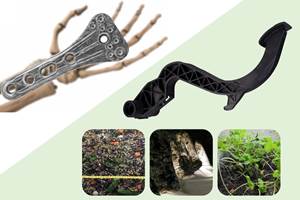DLR closes the loop in fiber-reinforced 3D printing with EmpowerAX, SchallFTP projects
Building on its work in EmpowerAX, the DLR and partners now aim to create a standardized, certifiable value chain that turns fiber waste into consistently reinforced thermoplastic filaments for 3D printing.
Share
Source (All Images) | DLR
At the EmpowerAX InnovationLab, the DLR Institute of Lightweight Systems (Braunschweig, Germany) has worked together with partners from research and industry domains to explore how additive extrusion with continuous fiber reinforcement can be industrialized across various application areas — from aerospace to mobility. The focus has been on the entire process chain, from filament production and printing to the functionally integrated lightweight structure. CW published an overview of the EmpowerAX open platform in 2023.
Building directly on these findings, DLR is actively pursuing the SchallFTP project, which aims to apply a sonic infusion cell for the impregnation and manufacture of fiber-reinforced thermoplastic semi-finished products — such as filaments — in an industrial context. A key area of the project is the advancement of circular economy principles within additive manufacturing. Central to this is the question of how fiber waste can be transformed into new, pseudo continuously reinforced 3D printing filaments in a resource-efficient, cost-effective way with strong application potential.
One thing is clear: carbon fiber-reinforced plastics (CFRP) retain significant material value, even at the end of their service life. Landfilling such materials is not only environmentally questionable but also heavily restricted by EU legislation (1999/31/EC). Against this backdrop, DLR is developing a process within the SchallFTP project that will enable efficient recycling of production waste and reject components into high-quality filaments for fiber-reinforced 3D printing.
Comparison of strengths of vCF- and rCF-based filaments.
To achieve this, carbon fibers coming from production rejects and waste (rCF) are combined with high-performance thermoplastics (such as PPS) through a specially adapted impregnation process. This in-house method enables a fiber volume content of up to 50%, while maintaining minimal degradation, thus making the recycled fibers viable for industrial use. The resulting filaments offer comparable design freedom to those made with virgin carbon fibers (vCF), while significantly reducing both costs and resource consumption, the DLR reports. This makes them particularly attractive for non-load-bearing applications in aerospace, automotive and other mobility sectors, ranging from cabin components to structural parts in vehicle construction.

Illustration on the subject of rCF.
The DLR’s goal is to preserve the material value of rCF as much as possible, closing the loop in lightweight construction in a truly sustainable way. Future research will focus on the reliable processing of different recyclates, particularly regarding fiber quality, contamination and ageing. The objective is to establish robust, industry-ready processes that enable reproducible transformation of recycled fibers into new semi-finished products from filament to functional structure.
Thermoplastic matrix systems also play a key role here. Targeted use of these materials is expected to simplify and accelerate recycling processes. Supported by simulation methods and new quality standards, these efforts aim to boost industry confidence in the use of recycled fibers. In the long term, the DLR seeks to work closely with material producers and application industries to create a standardized, certifiable value chain for rCF-based products.
Insights into the latest developments in high-performance fiber recycling will be presented at the annual on Oct. 8, 2025 in Stade, Germany. The topic will be showcased as one of many exciting research focal points. Participating researchers look forward to engaging directly with attendees and jointly discussing the next steps toward a sustainable, circular fiber-processing future.
Related Content
Bioabsorbable and degradable glass fibers, compostable composite parts
ABM Composite offers sustainable options and up to a 60% reduction in carbon footprint for glass fiber-reinforced composites.
Read MoreWatch: A practical view of sustainability in composites product development
Markus Beer of Forward Engineering addresses definitions of sustainability, how to approach sustainability goals, the role of life cycle analysis (LCA) and social, environmental and governmental driving forces. Watch his “CW Tech Days: Sustainability” presentation.
Read MoreASCEND program completion: Transforming the U.K.'s high-rate composites manufacturing capability
GKN Aerospace, McLaren Automotive and U.K. partners chart the final chapter of the 4-year, £39.6 million ASCEND program, which accomplished significant progress in high-rate production, Industry 4.0 and sustainable composites manufacturing.
Read MoreComposites end markets: Sports and recreation (2025)
The use of composite materials in high-performance sporting goods continues to grow, with new advancements including thermoplastic and sustainability-focused materials and automated processes.
Read MoreRead Next
DLR study considers cast PA6 molds for in situ AFP composites
3D printed thermoplastic mold was analyzed as alternative to expensive, time-consuming metallic molds and for suitability in aerospace-grade composite structure fabrication.
Read MoreInterfacial, CEAD launch strategic LFAM partnership
With the help of CEAD, Interfacial closes the gap between formulation and production-ready solutions made from 3D printed thermoplastic materials and functional composites.
Read MoreAll-recycled, needle-punched nonwoven CFRP slashes carbon footprint of Formula 2 seat
Dallara and Tenowo collaborate to produce a race-ready Formula 2 seat using recycled carbon fiber, reducing CO2 emissions by 97.5% compared to virgin materials.
Read More









